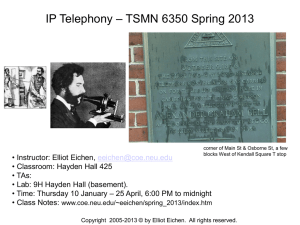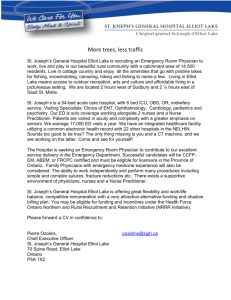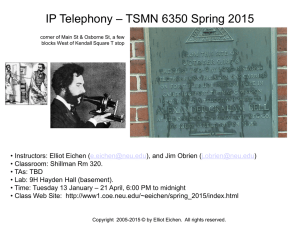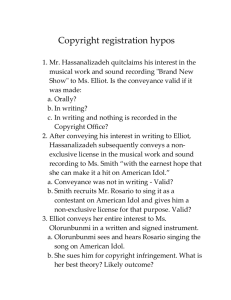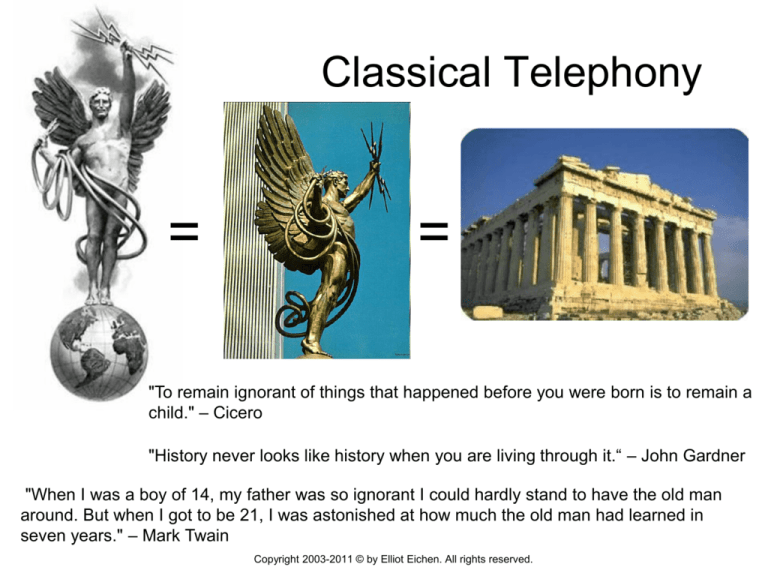
Classical Telephony
=
=
"To remain ignorant of things that happened before you were born is to remain a
child." – Cicero
"History never looks like history when you are living through it.“ – John Gardner
"When I was a boy of 14, my father was so ignorant I could hardly stand to have the old man
around. But when I got to be 21, I was astonished at how much the old man had learned in
seven years." – Mark Twain
Copyright 2003-2011 © by Elliot Eichen. All rights reserved.
Eichen’s fractured “History of Communications.”
Ancient History
Bell >> >> WWII
- analog telephony (loop start)
- carrier frequencies, modulation around
- copper wires& pumps
- mechanical co switches
Medieval
-TDM
WWII >> >> 1980 - microwave & ICs
- electronic switches
- software
Old Stuff
1980 >> >> 2000
New Stuff
2000 …
- optics (fiber, optoelectronics, amps)
- video & broadband (DSL, cable)
- wireless (1G, 2G), PCs
- VoIP (H323, SIP, RTP, ..) - FiOS
- video (& telepresence), - security
- wireless (3G, 4G – LTE / WiMax, VoLTE)
Copyright 2003-2010 © by
Eichen. All rights reserved.
- Elliot
Smartphones
& Tablets !!!!!
Copyright 2003-2011 © by Elliot Eichen. All rights reserved.
Prehistory
- visual signals, drums, horses, pigeons
<< A. Graham Bell - telegraph
{Aside: Golden Boy - How Competitive Life Is}
By KATHLEEN TELTSCH (The New
York Times); Metropolitan Desk
August 31, 1981, Monday
Late City Final Edition, Section B,
Page 3, Column 3, 435 words
[ DISPLAYING ABSTRACT ]
A painstaking restoration is under way
in a West Side warehouse of a 20,000pound bronze statue that once was a
familiar landmark in lower Manhattan.
For 64 years, the statue, the ''Spirit of
Communications'' stood atop the 26story headquarters of A.T.&T. at 195
Broadway. It was a heroic-sized
sculpture said to be one of the city's
largest single architectural figures,
possibly second in size only to the
Statue of Liberty.
Copyright 2003-2011 © by Elliot Eichen. All rights reserved.
Line Side Signaling & Digitization
Loop start or ground start analog signaling. {very little BRIISN digital signaling (Q.931)}. Bi-directional analog
transmission on twisted pair => use of “hybrid” at CO for
separating out inbound and outbound traffic.
End Office
PSTN Switch
Digitization of analog
waveform to 64 kbps
PCM at switch
Line Side (of the switch)
Trunk Side
Copyright 2003-2011 © by Elliot Eichen. All rights reserved.
PRI-ISDN: Digital Line Side
For PRI, Q.931 signaling on the D channel. For in-band PRI,
robbed bit signaling. Digitization to 64 kbits/s at the PBX, in
the handset, or both (transcoding by PBX). Sometimes endend digital => no hybrid (not a source for echo).
PBX
End Office
PSTN Switch
Line Side Trunk Side
4 wire digital T1 (one circuit for traffic to the switch,
one circuit for traffic away from the switch). Either
traditional repeated T1, or HDSL. Typically carried in
same outside twisted pair loop plant as analog traffic.
Copyright 2003-2011 © by Elliot Eichen. All rights reserved.
DSL
Copyright 2003-201` © by Elliot Eichen. All rights reserved.
Brief Aside: Broadband Access Technology (the last mile, =
the barrier to entry. Are there any $$s here?)
• ISDN (It Still Does Nothing)
– Just history (It Still Does Nothing refers to basic rate ISDN)
• DOCSIS et.al. (Data over Cable Services Spec)
– Often HFC: fiber to the head end with coax distribution
– Frequency modulation of sub-carriers, NGen digitial rather than analog
• DSL (Digital Subscriber Loop)
– Asymmetric (ADSL) or Symmetric (SDLS). (note also HDSL for T1).
• WiFi (LAN, not really an access technology. Also see Zigbee, and ZMax)
• Optical Transport
– Passively split fiber to the home (VZ FiOS), baseband TDM.
– Passively split fiber to the curb with VDSL distribution (AT&T). This really looks
more like the Cable Company architecture).
• Wireless: 3G, 4G (LTE and WiMax) (ah, WiMAX is now officially dead! –
2011). 4G will be metered, what about fixed broadband? Will 4G
disintermeidate wireless voice (do the same for wireless as wireline?)
• Other
– Power Lines (probably no traction here for WAN, but there is PLN for LAN).
– Satellite: geostationary and now low earth orbit (c.f. O3b Networks Ltd for
distribution, and HugesNet for access.)
– LMDS (point to multi-point
unusual
Copyrightmicrowave)
2003-2010 © by Elliot–pretty
Eichen. All rights
reserved. (Kathmandu Island Pk)
Digitization
G711 codec (CCIT standard)
8k samples/sec * 8 bits/sample = 64 kbits/s.
Companding (think of this a Dolby for telephony) is μlaw in North
America, ALaw in Europe, Africa, and Asia. Not sure about South
America.
{Shannon: 8 khz sampling frequency => 4 kHz max frequency
Component. In reality, voice passband is ~ 50Hz to 3 KHz}
Copyright 2003-2010 © by Elliot Eichen. All rights reserved.
PSTN – Network Architecture
Within the LATA:
Local Exchange Carrier (LEC) or
Competitive Local Exchange
Carrier (CLEC)
Between LATAs:
Inter Exchange Carrier
Within the LATA:
Local Exchange Carrier (LEC) or
Competitive Local Exchange
Carrier (CLEC)
Copyright 2003-2011 © by Elliot Eichen. All rights reserved.
SS7 – Out of Band Signaling for PSTN
Out of band, packet network for signaling and applications:
- highly redudent, X.25 like, network
- signaling:
- call setup (calling =>, progress<= alerting {ringing<=} )
- call tare down, etc.
-
applications:
- Call Name, 800 number resolution, LNP, AIN apps, etc.
Channelized, bi-directional 64kb/s “In-band” circuit switched network for
media (voice path).
Copyright 2003-2011 © by Elliot Eichen. All rights reserved.
SS7 Network Architecture
End Office Switches
IMT – Inter machine trunks
(voice circuits)
SS7 signaling
a: links
g: links
Copyright 2003-2011 © by Elliot Eichen. All rights reserved.
SS7 Network Architecture
dB apps
(like 800 #s,
also AIN)
Signaling
messages
X.25 like
Reliable transport at session level (similar function to TCP)
Copyright 2003-2011 © by Elliot Eichen. All rights reserved.
SS7 Example
Copyright 2003-2011 © by Elliot Eichen. All rights reserved.
PSTN Switched Services – 100 years of stuff
•
•
•
•
•
•
•
•
•
•
•
•
Voice
Fax
Modem
Digital (64 kb/s + bonding): small
Emergency (911, E911)
Toll Free (800), reverse toll (900)
Local Number Portability
Caller ID, Caller Name, Blocking, Original Called
Number, …
Wiretapping (Title 3, CALEA)
Operator Intervention
Fraud Management
Perceived Security (Privacy)
Copyright 2003-2011 © by Elliot Eichen. All rights reserved.
Routing & Telephone Numbers
• Routing rules are hard coded – circuit switches don’t
advertise telephone numbers, don’t discover routes, etc.
=> lots of administration (npa splits, carrier routing,..)
• E.164 telephone numbers are administered in the US by
NANPA – sort of the IANA for the PSTN. DOC awards
contract for administration, currently Nuestar – also
administer LNP, and .us/.biz top level domains.
• {TRIP – Telephony Routing over IP – advertising
telephone number space. Also ENUM – DNS resolution
of telephone numbers}
• Why haven’t URI’s replace TNs ??
Copyright 2003-2011 © by Elliot Eichen. All rights reserved.
Everything You Always Wanted to Know About
Communications Theory (1)
• Nyquist (aka Whittaker–Nyquist–Kotelnikov–Shannon) theorem:
– If an analog signal s(t) is bandlimited (has no frequency content higher than
Bmax), then one can perfectly reproduce the signal by sampling the function
at fn = 2 Bmax (or fn >= 2 Bmax ).
– Obviously important for digitizing real information streams – signal in time (t)
like speech or neurons firing, etc., or signal in space (x,y) like an image.
– For many practical reasons, you can’t perfectly reproduce anything, but you
can get arbitrarily close depending upon how hard you work (over sample,
longer windows, better precision, etc.), and how much noise is introduced
by the digitization process.
– You can also turn the argument around – if you sample the function at fs,
then the highest frequency component that can be reproduced is fs/2.
– An interesting question is how do compression algorithms – audio codecs,
image compression, etc. - “get around” Nyquist.
Copyright 2003-2011 © by Elliot Eichen. All rights reserved.
Everything You Always Wanted to Know About
Communications Theory (2)
• Wiener–Khinchin (aka Wiener–Khinchin–Einstein or Khinchin–
Kolmogorov) theorem:
– The Power Spectrum of a signal is the Fourier Transform of the AutoCorrelation of the
signal, which is the convolution of the signal with the complex conjugate of itself, or
– Given that the Fourier Transform of a convolution is the product of the individual
Fourier transforms, this can be written (in it’s most useful form) as
– Often folks look at the power spectrum of something on a log scale (for example, on a
spectrum analyzer in the lab). From a practical perspective, the power spectrum that
you see on the instrument is thus:
– Note that all the usual stuff around Linear Shift Invariant Systems, integerable
functions, etc. apply to this.
Copyright 2003-2011 © by Elliot Eichen. All rights reserved.
Aside: Power Spectrum of an NRZ signal
• Baseband, First Zero in the Power Spectrum is 1/T (bit length)
• Need to discuss coding (balancing 0 and 1), etc.
•
Copyright 2003-2011 © by Elliot Eichen. All rights reserved.
Everything You Always Wanted to Know About
Communications Theory (3)
•
•
Queuing Theory:
– Erlang (Danish engineer working for the Copenhagen Telephone Company
early 1900s). Offered load on a system due to the random (Poisson distributed)
arrival of requests and the length of time each request requires to service.
Erlang B Model:
– Calculates the probability that a request for service will be blocked given a
random (Poisson distributed) arrival of requests at rate r, an average time h
required to service the request, and N resources to service the request.
Assumes an infinite pool of requestors, but no queuing of a requests that
cannot be serviced
– Erlang B is good for calls that go to DSPs, trunks, etc. There is no queuing,
either the call gets accepted, or it gets dropped. If dropped, it does not add to
the overall arrival rate of requests.
– Erlang C introduces queuing of requests that cannot be serviced (e.g., call
center).
– Most folks either use a calculator, or calculate it recursively (converges quickly).
Or, for back of the envelope, use the rule of thumb of 52 mou/hour availability.
Copyright 2003-2011 © by Elliot Eichen. All rights reserved.
Everything You Always Wanted to Know About
Communications Theory (3a)
•
Erlang B Continued:
•
Rule of thumb: in the limit of large N, each resource contributes 52 MOU/hour.
•
Also, you might be interested in queing theory as it relates to Packet (Statistical) Networks, and to IP in
particular. Some of the important contributions are from : Kleinrock (USLA, early Arpanet operations, also
early packet queueing more in line with X.25, before IP), Licklider (BBN – he lived in Arlington!, I’m told that
he basically put forth almost the complete architecture of an IP based, best effort packet network), Vint Cerf
and Bob Kahn (TCP). Many other contributions, look at the Wikidpedia article on the Internet. Also look the
predecessors – X.25, frame relay, SS7.
Copyright 2003-2011 © by Elliot Eichen. All rights reserved.
Everything You Always Wanted to Know About
Communications Theory (4)
•
Really hard stuff: Voice Coding (Codecs) –
– Somewhat simple ideas (like the compandiing in G711 a or mu),
– To much more complex methods:
• ADPCM (e.g., G726.)
• Hybrid /A BS: GSM. {little known – GSM lowers bit rate as recevied
signal decreases, to maintain an acceptable S/N. }
• CLEP (code excited linear predictive – I don’t know what this means):
G729, G723, iLBC
– Look at Herssant’s book if you are interested.
•
More really hard stuff: Echo Cancelation
– OK, this is not quite as hard as CLEP codecs, it’s more or less figuring out
where the echo is (in time), and feeding the negative of received signal back
into the signal with the right delay/amplitude/phase.
– It’s still hard.
•
Signal processing is fun these days (it’s just code). The math is fun (but
hard), and the code is fun (but frustrating). Take a class on signal
processing.
Copyright 2003-2011 © by Elliot Eichen. All rights reserved.
Speech Coders: Lots of Code, DSP intensive
Copyright 2003-2010 © by Elliot Eichen. All rights reserved.
Summary: Classical Telephony
• Line Side (access) vs. Trunk Side (multiplexed)
• In-band signaling (loop start/robbed bit T1) vs. out of band
(SS7 .. and => VoIP)
• Digitization (=> digitization + packetization for VoIP).
• Broadband/access – barrier to entry, the only game left in
town for wired networks (and wireless soon ..)
• Stacks/layers/protocols: {POTS}, {Q.931/ISUP,
SS7/CSS7}, {T1 .. SONET}, {ATM, Frame,}
{IP, SIP, RTP}
• Services, Services, Services, Services ……
• Classical Communications Theory: Nyquist, WienerKhintchin, Erlang.
Copyright 2003-2011 © by Elliot Eichen. All rights reserved.
Copyright 2003-2011 © by Elliot Eichen. All rights reserved.
RTP
• RTP – carries real time data.
• RTPC – control port that carries
information to monitor quality of service.
+1 port
Copyright 2003-2010 © by Elliot Eichen. All rights reserved.
Bandwidth requirement: G729 Example
• Two 10 ms frames/packet (RTP default). For G729, voice is 8 kbps.
• Packet payload size = 2 X 8 kbps X 20ms = 160 bits = 20 octets/packet.
IP Packet = 60 bytes.
IP 20 bytes
UDP
RTP G729 Payload
8 bytes 12 bytes
20 bytes
• For Cisco HDLC (cisco-cisco router serial), add 5 bytes header, 3 bytes
trailer. Bandwidth = (63 bytes/20ms)*(8 bits/byte) = 25.2 kbps
HDLC
5 bytes
IP 20 bytes
UDP
RTP G729 Payload HDLC
8 bytes 12 bytes
20 bytes 3 bytes
• For ethernet, 14 byte header, 4 byte trailer =>
Bandwidth = (78 bytes/20ms)*(8bits/byte) = 31.2 kbps
Copyright 2003-2010 © by Elliot Eichen. All rights reserved.
CODEC table
Copyright 2003-2010 © by Elliot Eichen. All rights reserved.
Summary (PAMS listening score only)
Copyright 2003-2010 © by Elliot Eichen. All rights reserved.
Codecs – “Your mileage may vary”
• Large perceived quality difference between PSTN quality
(MOS=4.1) and cell quality (MOS=3.5)
• Codecs respond differently to packet loss, delay, noise,
multiple transcodings, etc. It’s not just the MOS/PSQM
measurement that counts.
• There are also licensing issues ($$), what the call is
being used for (messaging, conferencing, etc.), and DSP
HP required.
• The number of frames/packet can be dynamically
adjusted to tradeoff quality for efficiency.
• Header compression can drastically improve efficiency –
at the expense of router processing power.
• VoIP Community has – for the most part – converged
around G711, G729. Some application for G726 (packs
better into ATM). EE thinks that GSM interworking is
very important!
Copyright 2003-2010 © by Elliot Eichen. All rights reserved.
Bandwidth reduction
• IP – almost by definition - is less bw efficient than PSTN.
• Bandwidth reduction where the cost for bandwidth is at a
premium – typically tail circuits, or some international
destinations.
• VAD (Voice Activity Detection). Rule of thumb is 1/3-1/2
reduction in bw. Cost is voice quality (clipping), poor
performance in conferencing.
• Header Compression
– Compressed RTP: Hop-to-hop, requires
decompression and compression at each hop. For
G279, = 12.8 kb/s
– VoMPLS: New, not sure of what it takes beyond
MPLS. End-to-end (not hop-to-hop), likely to be much
less router CPU intensive.
Copyright 2003-2010 © by Elliot Eichen. All rights reserved.
Header Compression Example
• Conventional frame G729 = 25.2 kbps
HDLC
5 bytes
IP 20 bytes
UDP
RTP G729 Payload HDLC
8 bytes 12 bytes
20 bytes 3 bytes
• Compressed frame G729 = 12.8 kbps
HDLC
5 bytes
CRTP G729 Payload HDLC
4 bytes
20 bytes 3 bytes
Copyright 2003-2010 © by Elliot Eichen. All rights reserved.
Bandwidth reduction
• Voice carried as 64 kbps isochronous (heartbeat!) traffic
using G711.
• Signaling (mostly, US, EU,etc.) is out-of-band;
trunk side = ISUP SS7, line side = Q.931 PRI.
• Network services include modem, fax, some digital (64
kb/s clear channel) as well as voice. CName (caller id),
local number portability, 800 # translations, etc.
• Routing rules are hard coded, based on e.164 telephone
numbers – no RIP in telephony (see PINT). Lots of
administration (npa splits, carrier routing, etc.)
• Everything is regulated (PUC, FCC, DoC), tarriffed,
policed, and taxed!!
• ε business, efficient marketplace, size counts.
Copyright 2003-2010 © by Elliot Eichen. All rights reserved.

